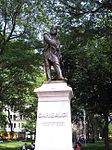Tamiment Library and Robert F. Wagner Archives
The Tamiment Library is a research library at New York University that documents radical and left history, with strengths in the histories of communism, socialism, anarchism, the New Left, the Civil Rights Movement, and utopian experiments. The Robert F. Wagner Archives, which is also housed in Bobst Library at NYU, documents American labor history. Together the two units form an important center for scholarly research on labor and the left. The Tamiment Library has a non-circulating collection of about 50,000 books, focusing on politics, political theory, labor, and radical literature and art movements. There are approximately 15,000 non-current periodical titles, including proceedings of labor union conventions, underground newspapers, internal bulletins of radical organizations, and scholarly journals. In addition, the library has a collection of about one million pamphlets and ephemera, including broadsides, leaflets, manifestos, reports, and other documents. The Tamiment Library and Wagner Archives together hold archival collections on organizations and individuals in the labor movement and left history, with special strengths in the New York City region.
Excerpt from the Wikipedia article Tamiment Library and Robert F. Wagner Archives (License: CC BY-SA 3.0, Authors).Tamiment Library and Robert F. Wagner Archives
Washington Square North, New York Manhattan
Geographical coordinates (GPS) Address Nearby Places Show on map
Geographical coordinates (GPS)
| Latitude | Longitude |
|---|---|
| N 40.7295 ° | E -73.9973 ° |
Address
New York University
Washington Square North
10012 New York, Manhattan
New York, United States
Open on Google Maps


